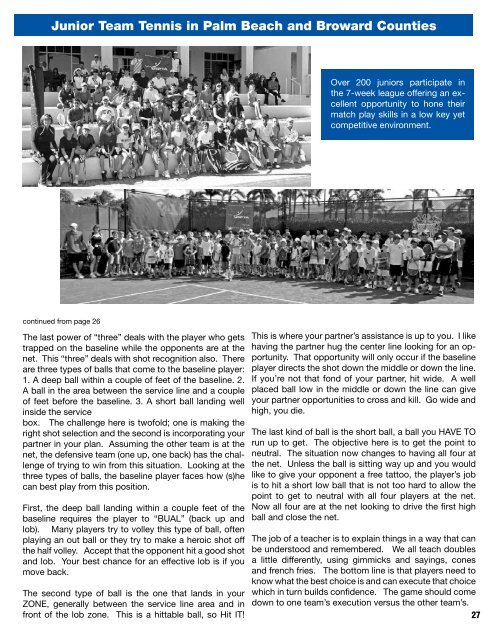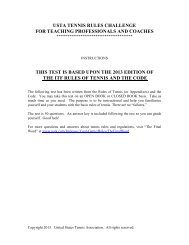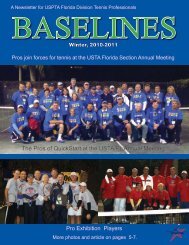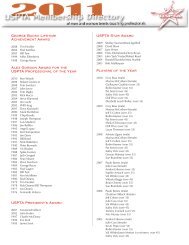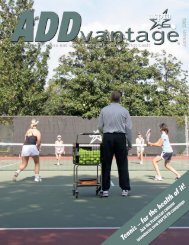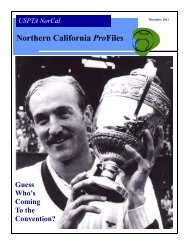Newsletter - United States Professional Tennis Association
Newsletter - United States Professional Tennis Association
Newsletter - United States Professional Tennis Association
You also want an ePaper? Increase the reach of your titles
YUMPU automatically turns print PDFs into web optimized ePapers that Google loves.
Junior Team <strong>Tennis</strong> in Palm Beach and Broward Counties<br />
Over 200 juniors participate in<br />
the 7-week league offering an excellent<br />
opportunity to hone their<br />
match play skills in a low key yet<br />
competitive environment.<br />
continued from page 26<br />
The last power of “three” deals with the player who gets<br />
trapped on the baseline while the opponents are at the<br />
net. This “three” deals with shot recognition also. There<br />
are three types of balls that come to the baseline player:<br />
1. A deep ball within a couple of feet of the baseline. 2.<br />
A ball in the area between the service line and a couple<br />
of feet before the baseline. 3. A short ball landing well<br />
inside the service<br />
box. The challenge here is twofold; one is making the<br />
right shot selection and the second is incorporating your<br />
partner in your plan. Assuming the other team is at the<br />
net, the defensive team (one up, one back) has the challenge<br />
of trying to win from this situation. Looking at the<br />
three types of balls, the baseline player faces how (s)he<br />
can best play from this position.<br />
First, the deep ball landing within a couple feet of the<br />
baseline requires the player to “BUAL” (back up and<br />
lob). Many players try to volley this type of ball, often<br />
playing an out ball or they try to make a heroic shot off<br />
the half volley. Accept that the opponent hit a good shot<br />
and lob. Your best chance for an effective lob is if you<br />
move back.<br />
The second type of ball is the one that lands in your<br />
ZONE, generally between the service line area and in<br />
front of the lob zone. This is a hittable ball, so Hit IT!<br />
This is where your partner’s assistance is up to you. I like<br />
having the partner hug the center line looking for an opportunity.<br />
That opportunity will only occur if the baseline<br />
player directs the shot down the middle or down the line.<br />
If you’re not that fond of your partner, hit wide. A well<br />
placed ball low in the middle or down the line can give<br />
your partner opportunities to cross and kill. Go wide and<br />
high, you die.<br />
The last kind of ball is the short ball, a ball you HAVE TO<br />
run up to get. The objective here is to get the point to<br />
neutral. The situation now changes to having all four at<br />
the net. Unless the ball is sitting way up and you would<br />
like to give your opponent a free tattoo, the player’s job<br />
is to hit a short low ball that is not too hard to allow the<br />
point to get to neutral with all four players at the net.<br />
Now all four are at the net looking to drive the first high<br />
ball and close the net.<br />
The job of a teacher is to explain things in a way that can<br />
be understood and remembered. We all teach doubles<br />
a little differently, using gimmicks and sayings, cones<br />
and french fries. The bottom line is that players need to<br />
know what the best choice is and can execute that choice<br />
which in turn builds confidence. The game should come<br />
down to one team’s execution versus the other team’s.<br />
27


